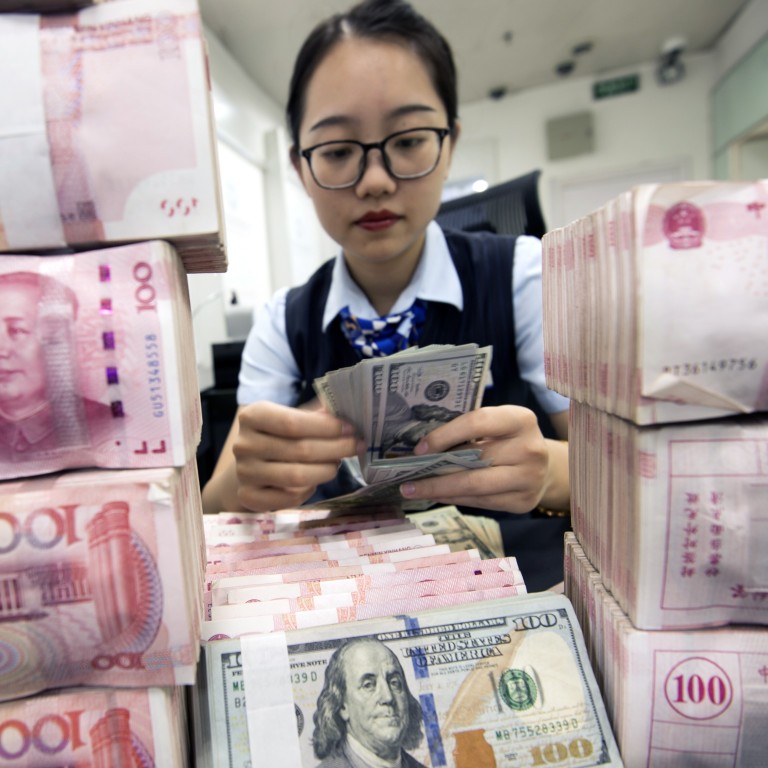
US dollar-yuan exchange rate: China sees currency rise as ‘relatively moderate’ despite concerns
- The yuan has gained around 7 per cent against the US dollar in the past six months amid escalating tensions between Beijing and Washington
- Concerns have been raised among analysts over the speed of the appreciation of the yuan
The rise of China’s yuan against the US dollar has been relatively moderate and it will still fluctuate around a reasonably balanced level, China’s foreign exchange regulator said Friday, signalling Beijing’s tolerance for the curreny’s recent rise amid escalating trade tensions with Washington.
Officially, the People’s Bank of China (PBOC) has stopped directly intervening in the exchange rate, instead leaving the market to decide the currency trend, but it still manages the exchange rate by setting the midpoint for the yuan’s allowable trading range each day.
“Overall, the appreciation of the yuan is relatively moderate. Since the beginning of this year, the yuan has appreciated by 4.5 per cent against the US dollar, the US dollar index has fallen by 4.3 per cent, the euro has appreciated by 5.9 per cent against the US dollar, and the Japanese yen has appreciated by 4.1 per cent against the US dollar. In comparison, the performance of the yuan is basically in line with major currencies,” said Wang Chunying, a spokeswoman for the State Administration of Foreign Exchange (SAFE).
“Under the combined effects of internal and external factors, the yuan exchange rate is expected to continue to maintain two-way volatility and basic stability at a reasonable and balanced level in the future.”
The PBOC, China’s central bank, set the midpoint of the daily trading range against the US dollar at 6.6703 on Friday, lower than Thursday’s rate of 6.6556, which was the strongest guidance rate since July 2018.
The higher exchange rate figure means it takes more yuan to buy one dollar, signalling a depreciation of the Chinese currency.
China still has the first mover advantage [against other exporters] because it has kept the coronavirus pandemic under control as global demand is showing signs of rebound
A report by Standard & Poor’s this week said that financial conditions have tightened in both inflation-adjusted interest rates and credit flows since May when policy easing hit its peak.
“If the currency strengthens too quickly, however, it could add to the drag on the economy from tighter financial conditions,” said the S&P’s report.
Frances Cheung, head of macro strategy for Asia at Westpac Banking Corporation, said the comments from SAFE reflected that policymakers were comfortable with the appreciation of the yuan in recent weeks, pointing to the weakness of the US dollar as the main driver.
“China still has the first mover advantage [against other exporters] because it has kept the coronavirus pandemic under control as global demand is showing signs of rebound,” said Cheung, adding that even though the yuan has risen, Chinese exports remain competitive as other exporting nations are still reeling from lockdown measures.
The central bank is currently more tolerant of yuan appreciation, which is in line with the central bank’s goal of increasing the flexibility of the yuan exchange rate
Wang Tao, chief China economist at UBS, wrote in the official the Economic Daily on Friday that China’s central bank has previously resisted a rising yuan to keep its exports competitive because of the trade war with the United States, but its policy direction may now have changed, signalling its tolerance for a stronger yuan.
“Taking into account the relevant speeches made by the leaders of the central bank on advancing the internationalisation of the yuan, we believe that this means that compared with the past, the central bank is currently more tolerant of yuan appreciation, which is in line with the central bank’s goal of increasing the flexibility of the yuan exchange rate,” UBS’ Wang Tao added.
“We have raised our forecast for the yuan exchange rate against the US dollar at the end of this year and next year to 6.5.”
“Benefiting from the support of multiple fundamental factors, coupled with the increased tolerance of the central bank for yuan appreciation, increased exchange rate flexibility, and the possibility of a significant deterioration in Sino-US relations in the short term, the yuan is likely to appreciate further against the US dollar,” said Wang Tao from UBS.
“However, we believe that the central bank will still ease the appreciation of the yuan by relaxing capital controls and adjusting the central parity of the yuan exchange rate when necessary.”

